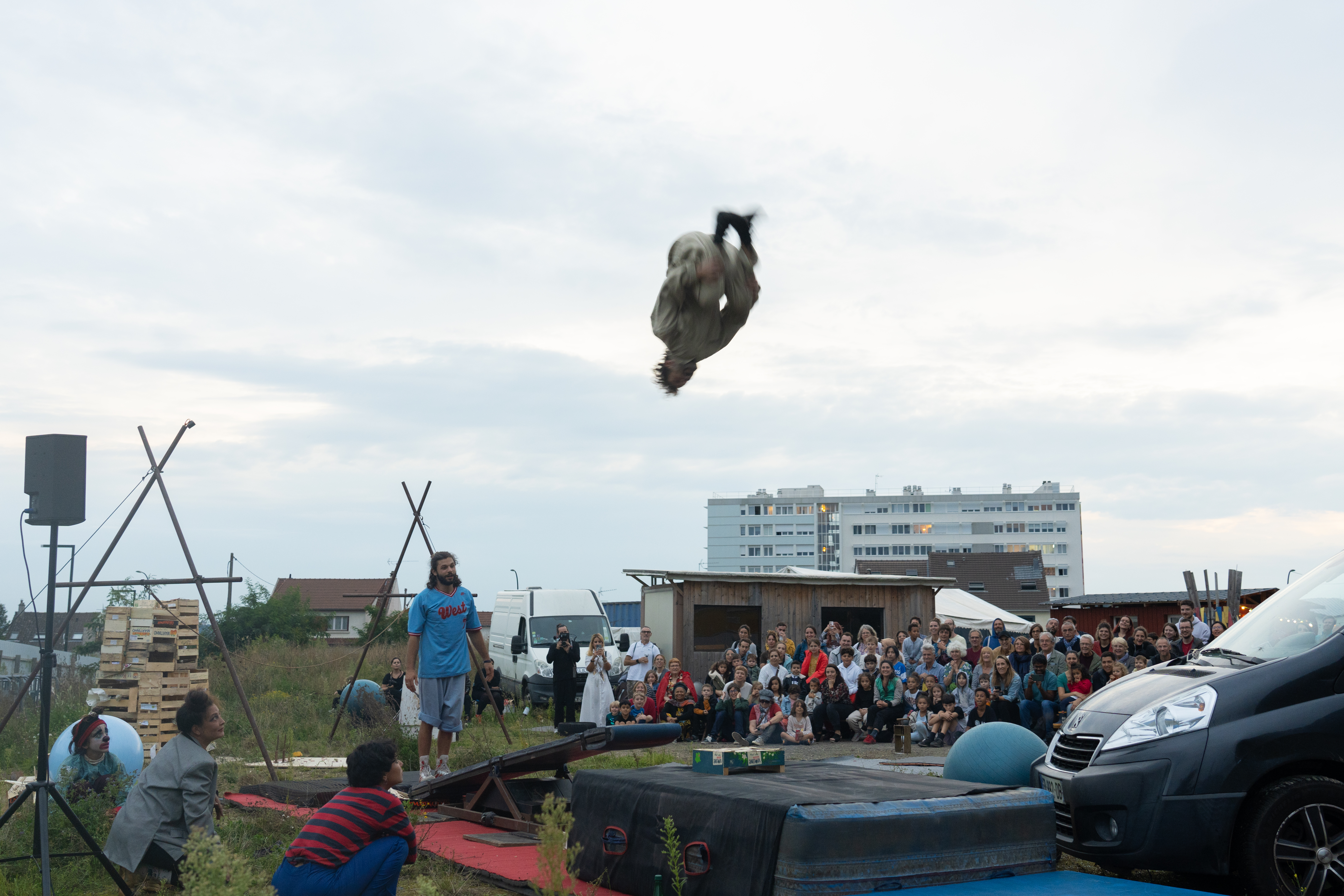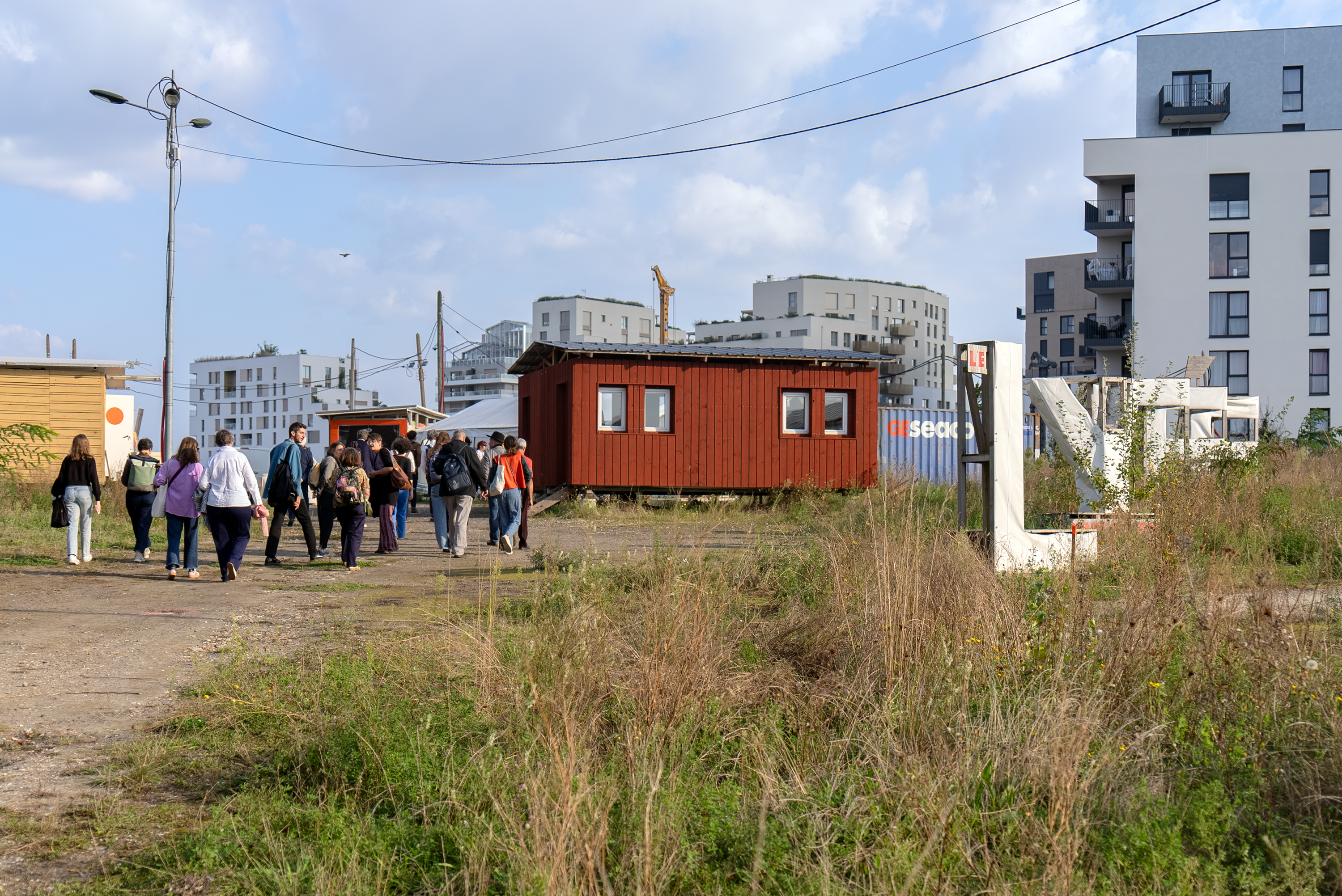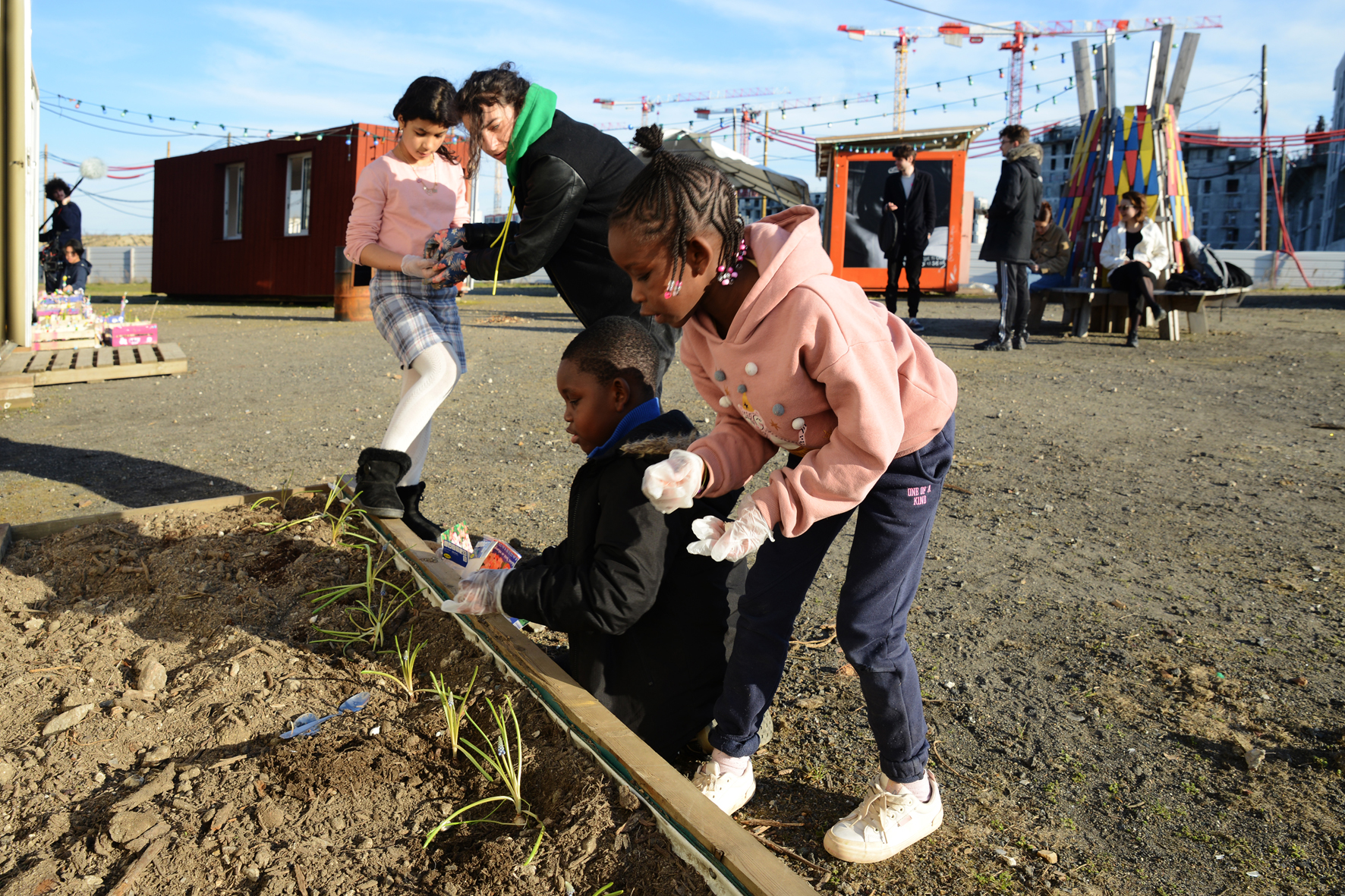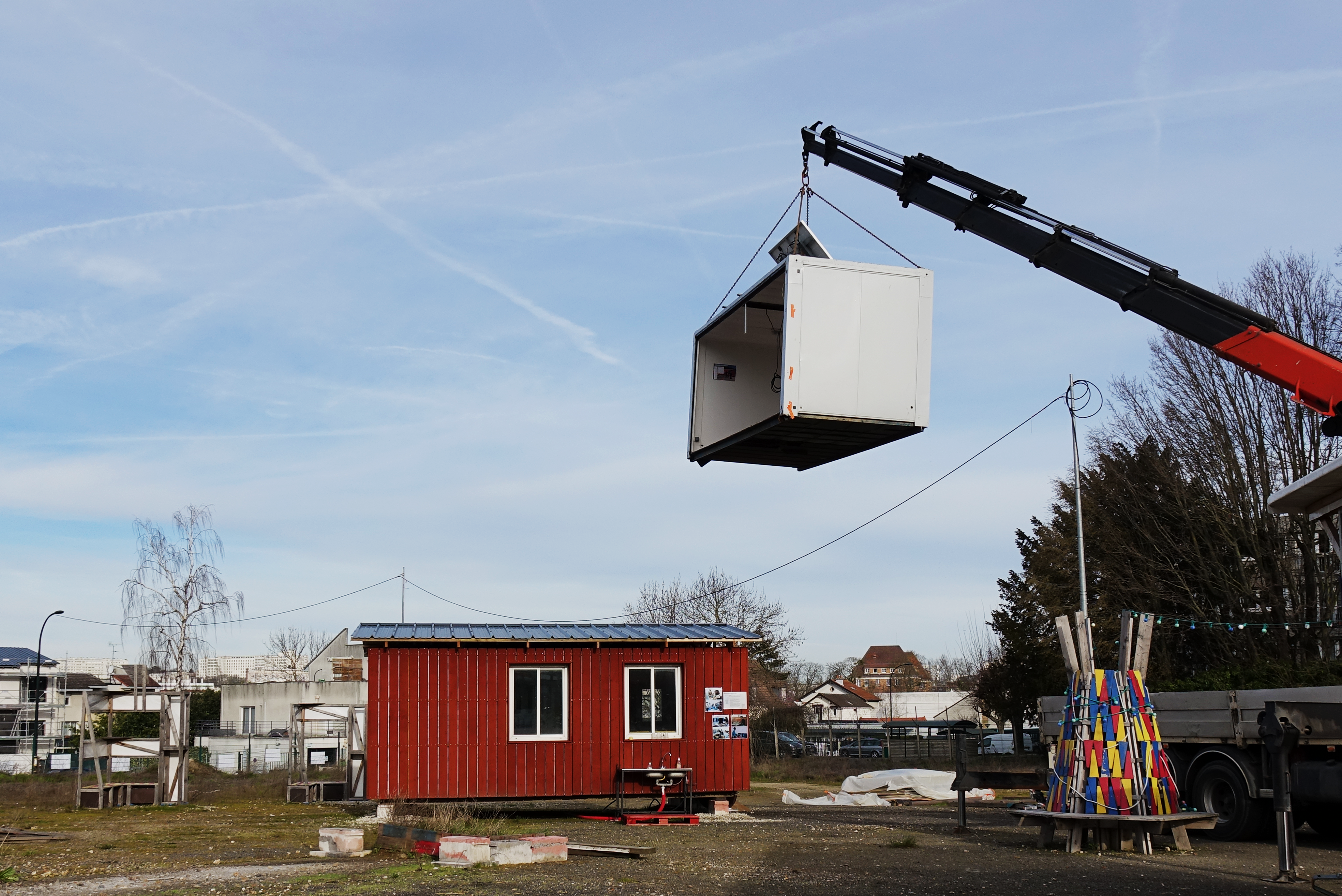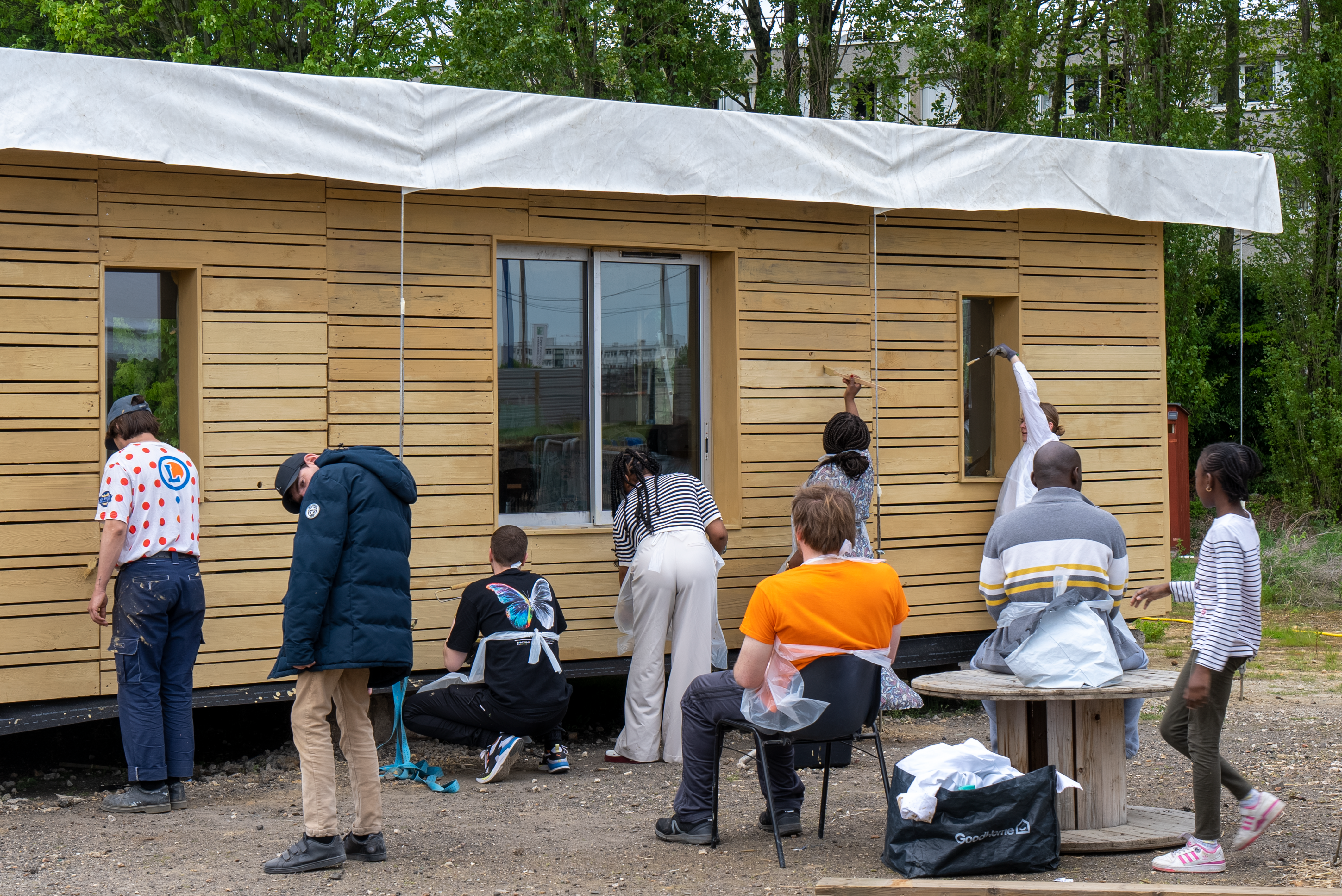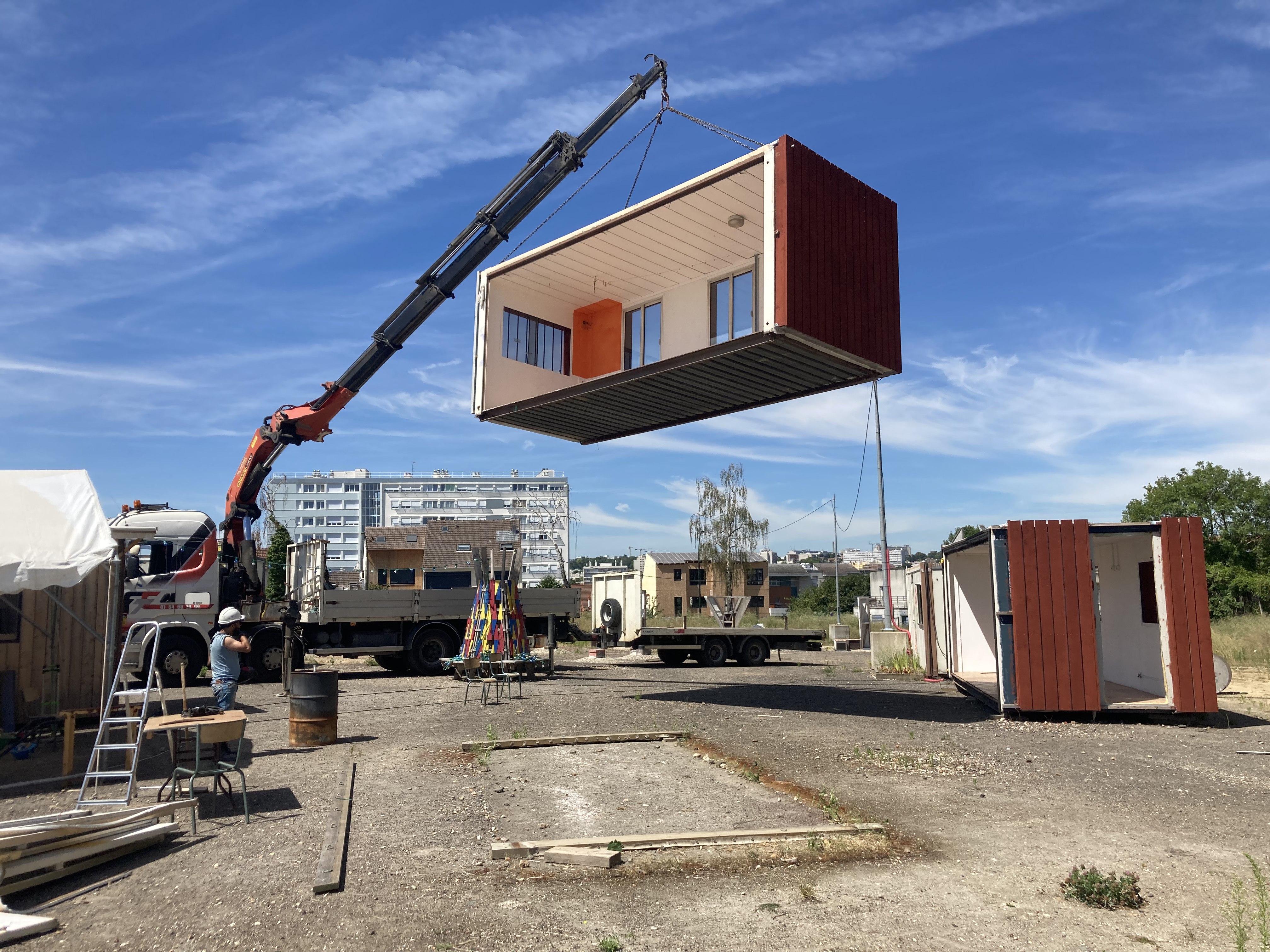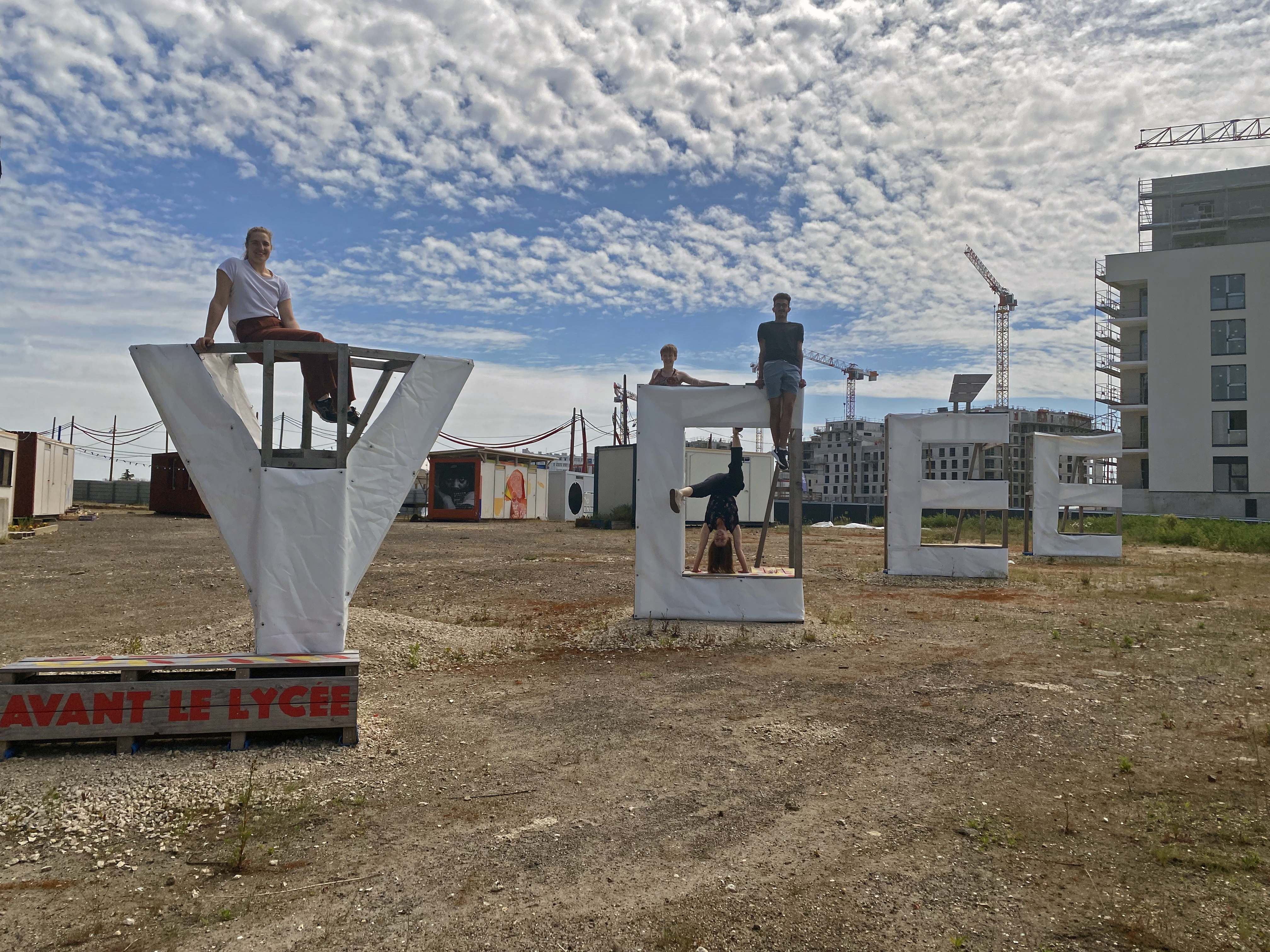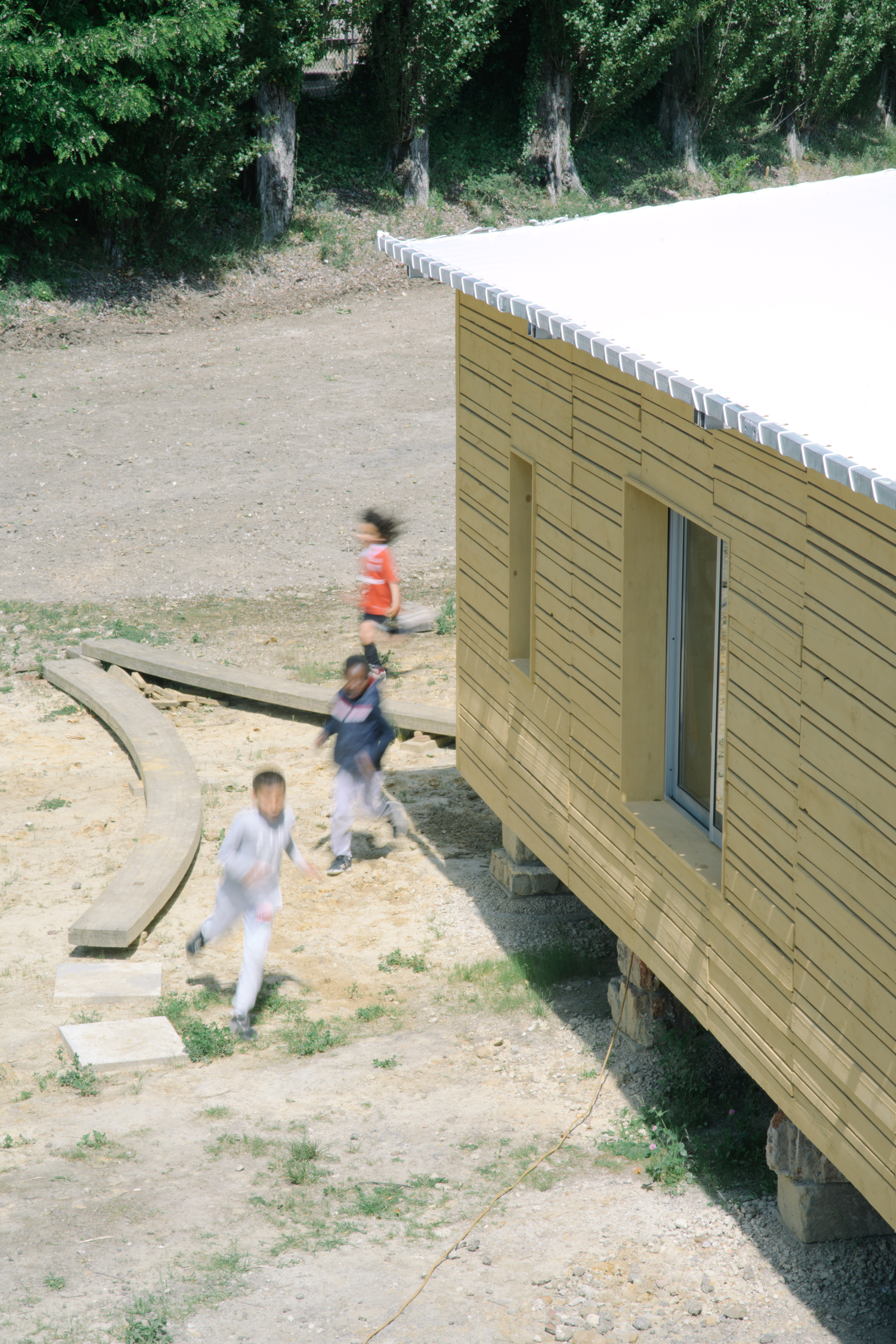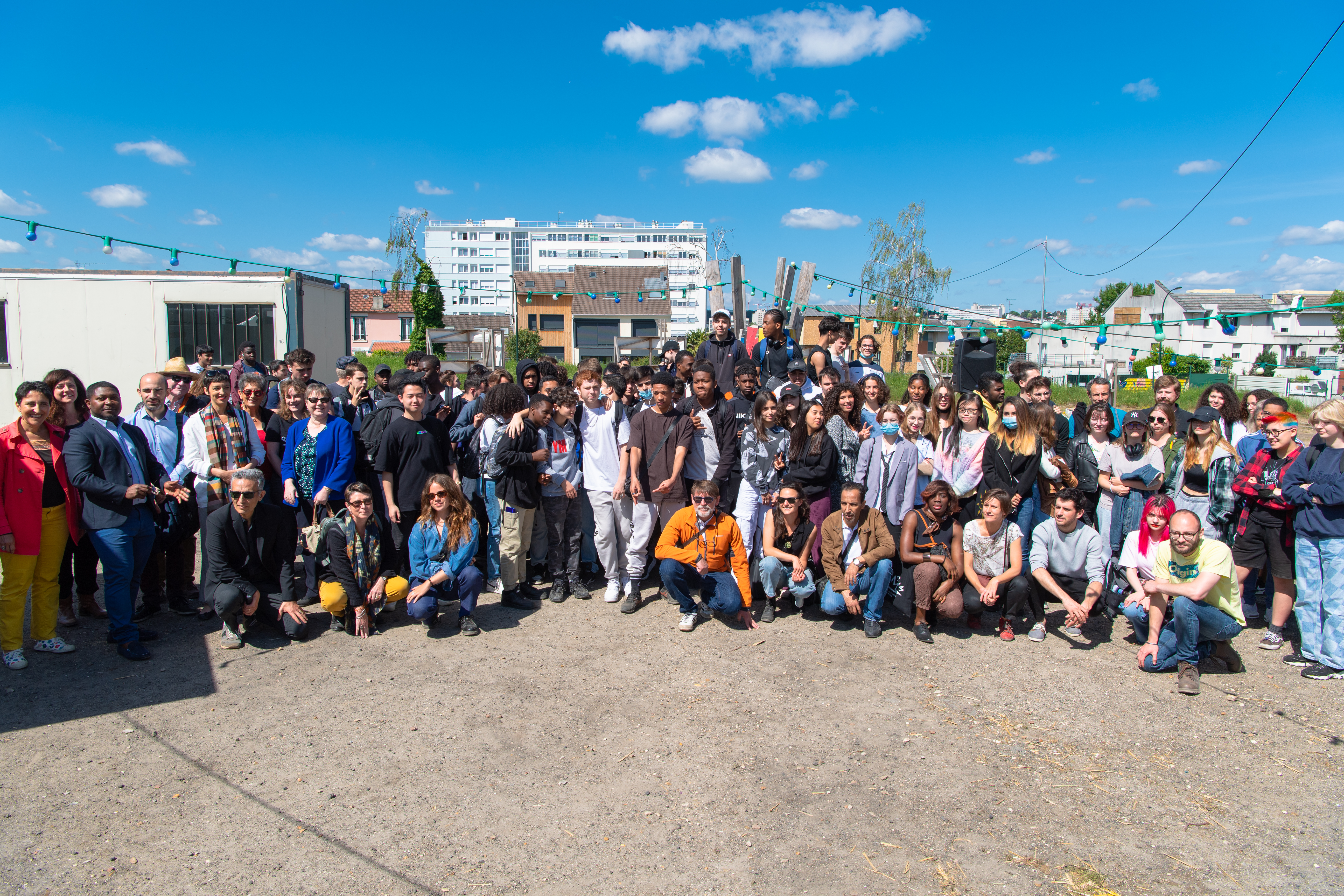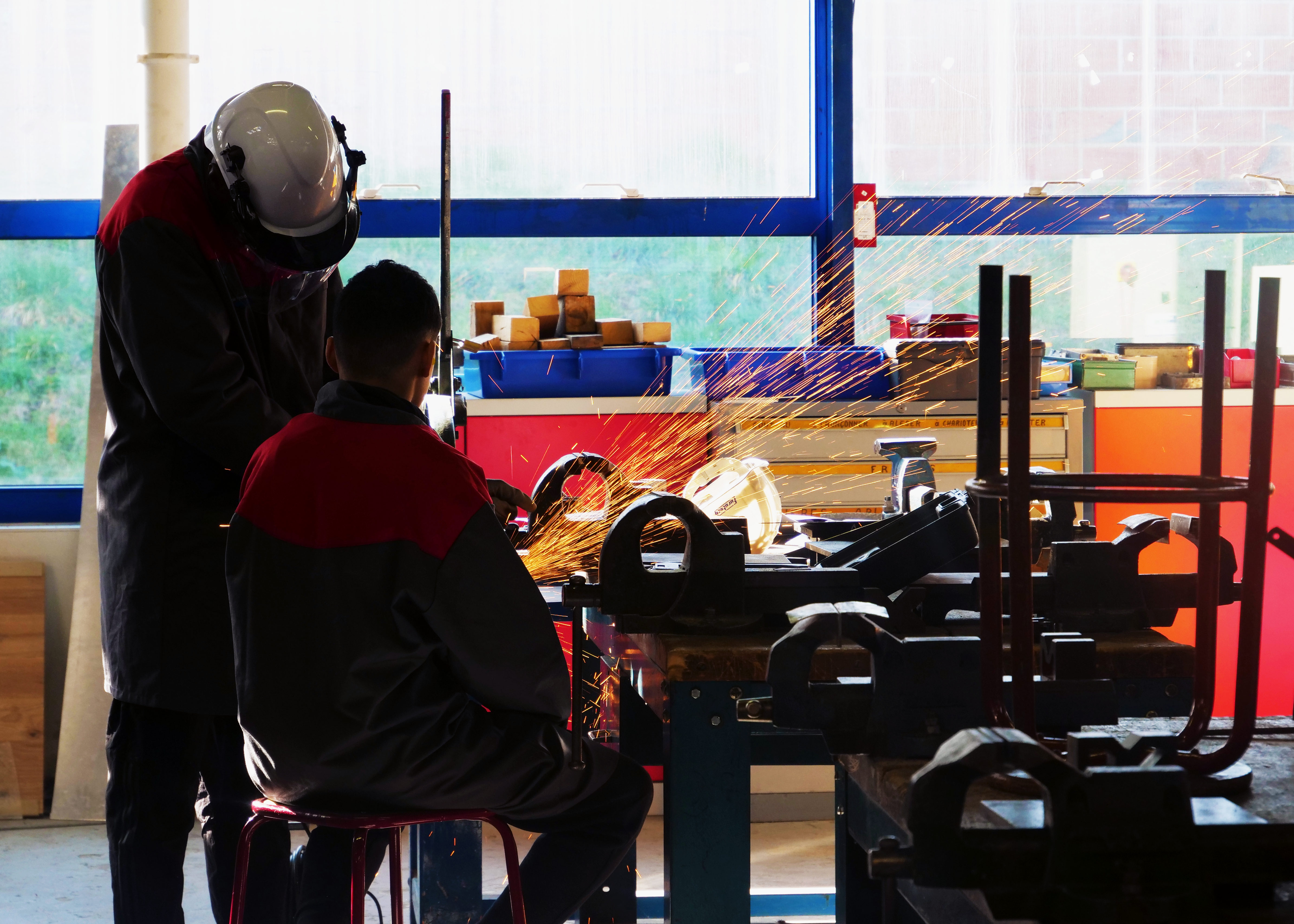Prioritising the places and people that need it the most
Le lycée avant le Lycée
{Empty}
the “Lycée avant le Lycée” project proposes to demonstrate the opening of the doors of the high school before its construction, by transforming the classic exercise of building a school into an experimental, cultural and open worksite installed on the site itself from 2019.
France
Regional
Ile-de-France
Mainly urban
It refers to other types of transformations (soft investment)
Yes
2024-12-31
No
No
No
As a representative of an organisation
Since its creation in 1992, PPCM (“the smallest circus in the world”) has established itself as a cultural laboratory, combining a circus arts school, creative workshops, and a variety of public events. In 2014, the team moved into an experimental building designed by architects Loïc Julienne and Patrick Bouchain (National Prize of Urban Planning 2019) in the southern suburbs of Paris, where they implemented innovative urban and architectural strategies. Among these, the concept of architectural permanence stands out as a collaborative design process within an “open construction site,” where users, workers, and the public share the space as it evolves.
This approach was further developed in 2019 with the project Le Lycée avant le Lycée (“The High School Before the High School”), a collaboration between PPCM, the Municipality of Bagneux, and Patrick Bouchain’s national project La Preuve par 7. On the site of the future general and technological high school of Bagneux, this initiative aims to co-create the school’s design and program with local residents and young people. The project encourages citizens to engage with urban planning issues and to shape the school through a shared, participatory process.
In practical terms, PPCM and its partners offer a rich and varied program on the future high school site, including participatory construction workshops, artistic residencies focused on circus arts, university conferences, and design/creation workshops with local high school students. By opening the construction site to public dialogue and creative engagement, architectural permanence anticipates and adapts the project to the needs and aspirations of its future users, fostering an innovative model of education and collective construction.
This approach was further developed in 2019 with the project Le Lycée avant le Lycée (“The High School Before the High School”), a collaboration between PPCM, the Municipality of Bagneux, and Patrick Bouchain’s national project La Preuve par 7. On the site of the future general and technological high school of Bagneux, this initiative aims to co-create the school’s design and program with local residents and young people. The project encourages citizens to engage with urban planning issues and to shape the school through a shared, participatory process.
In practical terms, PPCM and its partners offer a rich and varied program on the future high school site, including participatory construction workshops, artistic residencies focused on circus arts, university conferences, and design/creation workshops with local high school students. By opening the construction site to public dialogue and creative engagement, architectural permanence anticipates and adapts the project to the needs and aspirations of its future users, fostering an innovative model of education and collective construction.
architecture
education
experimentation
heritage
landscape
The Le Lycée avant le Lycée project adopts an integrated approach to sustainability, responding to the challenges of climate change, circularity, zero pollution and biodiversity preservation. In our work and in the prefiguration of the Lycée site, we give priority to biosourced, reused and local materials, thereby reducing our carbon footprint and limiting waste production. In this way, we are proposing an exemplary model in terms of green energy.
We also embrace the values of social ecology, involving local know-how in the project: the worksite becomes a learning space where young people and local residents not only get involved in the construction of the site, but also contribute their expertise. We take care to involve a diverse public (age, social class, gender...) so that everyone can participate in the project at their own level.
The notion of landscape is also central, as we are convinced that children's relationship with the outdoors is the key for learning. We are also prefiguring outdoor spaces in connection with the future high school. We are also part of an important experimental landscape fabric, interacting with the Agrocité de Bagneux (New European Bauhaus Prizes 2022) to design the landscaping and make future users aware of the importance of protecting them.
We also embrace the values of social ecology, involving local know-how in the project: the worksite becomes a learning space where young people and local residents not only get involved in the construction of the site, but also contribute their expertise. We take care to involve a diverse public (age, social class, gender...) so that everyone can participate in the project at their own level.
The notion of landscape is also central, as we are convinced that children's relationship with the outdoors is the key for learning. We are also prefiguring outdoor spaces in connection with the future high school. We are also part of an important experimental landscape fabric, interacting with the Agrocité de Bagneux (New European Bauhaus Prizes 2022) to design the landscaping and make future users aware of the importance of protecting them.
The Lycée avant le Lycée project places aesthetics and quality of experience at the heart of its approach, using design and cultural engagement to create an inspiring and inclusive space. The project transforms the traditional school construction process into an artistic and participatory experiment, where architecture is shaped by its future users. Through an open construction site, students, teachers, and local residents actively contribute to the design, ensuring the space reflects their aspirations and needs.
Aesthetically, the project embraces raw and repurposed materials, celebrating imperfection and adaptability as design principles. The integration of artistic interventions, circus performances, and creative workshops enriches the environment, turning the school into a living cultural space. The architectural process itself becomes a collective experience, reinforcing a sense of belonging and pride among participants.
Culturally, the initiative fosters interaction between disciplines, blending education, architecture, and performing arts to enhance learning. By incorporating artistic residencies and workshops, it cultivates creativity and strengthens the emotional connection between users and their environment. This model redefines the role of public architecture, proving that schools can be built not just as functional spaces, but as vibrant, evolving cultural landmarks.
Aesthetically, the project embraces raw and repurposed materials, celebrating imperfection and adaptability as design principles. The integration of artistic interventions, circus performances, and creative workshops enriches the environment, turning the school into a living cultural space. The architectural process itself becomes a collective experience, reinforcing a sense of belonging and pride among participants.
Culturally, the initiative fosters interaction between disciplines, blending education, architecture, and performing arts to enhance learning. By incorporating artistic residencies and workshops, it cultivates creativity and strengthens the emotional connection between users and their environment. This model redefines the role of public architecture, proving that schools can be built not just as functional spaces, but as vibrant, evolving cultural landmarks.
The Lycée avant le Lycée project places inclusion at its core, addressing accessibility, participatory governance, and social diversity. Located in a Quartier Prioritaire de la Ville (QPV – Priority Urban District), the project fosters social cohesion by bringing together students, teachers, residents, and professionals. It actively involves vocational school students, local associations, and cultural actors, creating a shared space for exchange and participation, where a sense of belonging grows over time.
Accessibility and affordability are ensured through free workshops and public events, making cultural and educational activities available to populations with limited access. Its flexible scheduling and temporary infrastructure lower participation barriers.
The participatory governance model empowers participants by involving them in decision-making, ensuring that the future school reflects the needs of its users. Regular public gatherings, co-design workshops, and collaborative events reinforce this inclusive approach. Cooperation between institutions, associations, and residents allows continuous adaptation to community needs.
Beyond shaping the future high school of Bagneux, Le Lycée avant le Lycée serves as a model for rethinking public spaces and education. By integrating students and residents into urban and architectural planning, it challenges traditional top-down models, advocating for more inclusive and community-driven design. Its experimental and adaptable methodology makes it a replicable initiative that can inspire similar projects in other territories.
Accessibility and affordability are ensured through free workshops and public events, making cultural and educational activities available to populations with limited access. Its flexible scheduling and temporary infrastructure lower participation barriers.
The participatory governance model empowers participants by involving them in decision-making, ensuring that the future school reflects the needs of its users. Regular public gatherings, co-design workshops, and collaborative events reinforce this inclusive approach. Cooperation between institutions, associations, and residents allows continuous adaptation to community needs.
Beyond shaping the future high school of Bagneux, Le Lycée avant le Lycée serves as a model for rethinking public spaces and education. By integrating students and residents into urban and architectural planning, it challenges traditional top-down models, advocating for more inclusive and community-driven design. Its experimental and adaptable methodology makes it a replicable initiative that can inspire similar projects in other territories.
The Lycée Avant le Lycée project involves beneficiaries and civil society at different levels.
Young people, especially high school students, have been placed at the heart of the process, not only as beneficiaries but also as active participants in transforming their future educational space. Through workshops, collaborative construction projects, and educational experiments, they have actively contributed to the design and creation of concrete elements for their school, developing practical skills and strengthening their autonomy.
Local residents and community organizations have also played a key role. Some have participated in collaborative construction projects and cultural events, contributing to the project's collective momentum. Over time, residents have begun to take ownership of the site, although challenges remain in terms of accessibility and the project's visibility to the general audience.
Institutions and partners have provided crucial support, both financially and in terms of expertise. Collaboration with architects, artists, and educators has enabled the exploration of new educational and urban approaches. This synergy has turned the L.A.L. into a true laboratory for social and educational innovation, directly addressing local challenges.
This involvement has had tangible effects: strengthening the sense of belonging among young people and residents, creating a more interactive and engaging learning experience, and fostering new forms of governance and collaboration. It presents a more inclusive and experimental model of education and urban development.
Young people, especially high school students, have been placed at the heart of the process, not only as beneficiaries but also as active participants in transforming their future educational space. Through workshops, collaborative construction projects, and educational experiments, they have actively contributed to the design and creation of concrete elements for their school, developing practical skills and strengthening their autonomy.
Local residents and community organizations have also played a key role. Some have participated in collaborative construction projects and cultural events, contributing to the project's collective momentum. Over time, residents have begun to take ownership of the site, although challenges remain in terms of accessibility and the project's visibility to the general audience.
Institutions and partners have provided crucial support, both financially and in terms of expertise. Collaboration with architects, artists, and educators has enabled the exploration of new educational and urban approaches. This synergy has turned the L.A.L. into a true laboratory for social and educational innovation, directly addressing local challenges.
This involvement has had tangible effects: strengthening the sense of belonging among young people and residents, creating a more interactive and engaging learning experience, and fostering new forms of governance and collaboration. It presents a more inclusive and experimental model of education and urban development.
The project involved stakeholders at different levels, each playing a crucial role in its implementation.
At the local level, the engagement of educational institutions (Lycées Léonard de Vinci, Adolphe Chérioux, Louis Girard) integrated the project into their educational programs, offering students hands-on workshops on architecture and urban planning. Local associations like Bagneux Environnement and Agrocité supported the youth in their reflections on sustainable development and territorial planning. The City of Bagneux facilitated the project’s integration into the local ecosystem by supporting educational and cultural events. Their involvement anchored the project in the local community, fostering collective ownership of educational and urban spaces.
At the regional level, the Île-de-France Region provided financial and institutional support, co-funding educational and cultural actions while fostering dialogue between educational and urban stakeholders. This support enabled the experimentation of new learning methods and helped extend the project’s impact to other institutions in the region.
At the national level, institutions such as Le Plus Petit Cirque du Monde played a key role in the project’s artistic and pedagogical direction. The project was recognized as a "Fabrique de Territoire" by the ANCT in 2021, which helped increase its visibility and structure the participatory approach. Financial contributions from private organizations ensured the funding for workshops and cultural events.
At the European level, the project was connected to broader dynamics of ecological transition and educational innovation. Exchanges with experimental structures in Europe helped explore models of educational third places and participatory urbanism. The involvement of international actors like the Atelier d'Architecture Autogéré enriched the project, placing it within European dynamics of innovation in education and and territorial planning.
At the local level, the engagement of educational institutions (Lycées Léonard de Vinci, Adolphe Chérioux, Louis Girard) integrated the project into their educational programs, offering students hands-on workshops on architecture and urban planning. Local associations like Bagneux Environnement and Agrocité supported the youth in their reflections on sustainable development and territorial planning. The City of Bagneux facilitated the project’s integration into the local ecosystem by supporting educational and cultural events. Their involvement anchored the project in the local community, fostering collective ownership of educational and urban spaces.
At the regional level, the Île-de-France Region provided financial and institutional support, co-funding educational and cultural actions while fostering dialogue between educational and urban stakeholders. This support enabled the experimentation of new learning methods and helped extend the project’s impact to other institutions in the region.
At the national level, institutions such as Le Plus Petit Cirque du Monde played a key role in the project’s artistic and pedagogical direction. The project was recognized as a "Fabrique de Territoire" by the ANCT in 2021, which helped increase its visibility and structure the participatory approach. Financial contributions from private organizations ensured the funding for workshops and cultural events.
At the European level, the project was connected to broader dynamics of ecological transition and educational innovation. Exchanges with experimental structures in Europe helped explore models of educational third places and participatory urbanism. The involvement of international actors like the Atelier d'Architecture Autogéré enriched the project, placing it within European dynamics of innovation in education and and territorial planning.
The Lycée Avant le Lycée project brings together multiple disciplines and knowledge fields, deeply influenced by the thinking of Patrick Bouchain, an architect known for his participatory and contextual approach. His philosophy, placing users at the center of design while encouraging experimentation, flexibility, and material reuse, has guided the project’s development.
Architecture and urban planning are at the heart of the project, rethinking learning spaces through temporary structures and adaptable layouts. Education plays a key role, with students actively involved in designing and building their future school, fostering practical skills and ownership. Artistic disciplines, including circus arts (in connection with the PPCM) and design, introduce creativity and new ways of experiencing spaces. Ecology informs the approach to sustainable construction, with attention to biodiversity and material reuse. Social sciences and participatory methods ensure that the voices of young people and the local community shape decisions.
Representatives from these fields work together through co-creation workshops, open construction sites, and creative events. For example, students from the École Nationale Supérieure d’Architecture de Paris-La Villette experimented with new learning approaches on-site. The Local Council of Architecture - CAUE92 - contributed expertise in urbanism, and local artists and artisans collaborated with students on installations. Researchers from La Preuve par 7 facilitated cross-sector dialogue.
This interdisciplinary process created a living laboratory, empowering students and residents, fostering creativity, and raising ecological awareness. The blending of arts, architecture, and education produced a flexible, innovative model for school design, making the construction site a place of both making and learning.
Architecture and urban planning are at the heart of the project, rethinking learning spaces through temporary structures and adaptable layouts. Education plays a key role, with students actively involved in designing and building their future school, fostering practical skills and ownership. Artistic disciplines, including circus arts (in connection with the PPCM) and design, introduce creativity and new ways of experiencing spaces. Ecology informs the approach to sustainable construction, with attention to biodiversity and material reuse. Social sciences and participatory methods ensure that the voices of young people and the local community shape decisions.
Representatives from these fields work together through co-creation workshops, open construction sites, and creative events. For example, students from the École Nationale Supérieure d’Architecture de Paris-La Villette experimented with new learning approaches on-site. The Local Council of Architecture - CAUE92 - contributed expertise in urbanism, and local artists and artisans collaborated with students on installations. Researchers from La Preuve par 7 facilitated cross-sector dialogue.
This interdisciplinary process created a living laboratory, empowering students and residents, fostering creativity, and raising ecological awareness. The blending of arts, architecture, and education produced a flexible, innovative model for school design, making the construction site a place of both making and learning.
The project transforms the construction of a school into an open and participatory site. Unlike traditional models where students are mere users, here they become active participants in shaping their learning environment by engaging with various disciplines such as architecture, circus, design, urbanism, social sciences, and ecology.
An "open site" and shared governance
In most school projects, design is left to experts with no input from users. Here, an architectural office enables students and residents to rethink the school space alongside architects and designers. The project implements shared governance, involving students, teachers, local authorities (City of Bagneux, Île-de-France Region), and a network of architects and researchers. This co-construction makes the project an educational innovation laboratory, where decisions are collaboratively made rather than imposed top-down.
Valuing manual skills by doing (“le faire”)
The project highlights manual craftsmanship through the "Lycée de Demain." Vocational high school students participate in designing and creating furniture and installations with collectives of builders and designers to improve their school, thus laying the foundation for the future Bagneux school.
Hybridizing disciplines and immersive pedagogy
One of the project's most innovative aspects is its interdisciplinary approach between architecture, urbanism, and the performing arts, particularly circus and dance. The PPPCM plays a key role by integrating circus arts into the educational process. Students reflect on the school space through artistic performances and physical scenarios. This blending of circus and architecture promotes a sensory and experiential appropriation of school spaces.
The project incorporates environmental thinking, focusing on:
Eco-construction and material reuse, creating architectural elements from recycled resources.
Experimenting with flexible spaces adaptable to educational and climate changes.
An "open site" and shared governance
In most school projects, design is left to experts with no input from users. Here, an architectural office enables students and residents to rethink the school space alongside architects and designers. The project implements shared governance, involving students, teachers, local authorities (City of Bagneux, Île-de-France Region), and a network of architects and researchers. This co-construction makes the project an educational innovation laboratory, where decisions are collaboratively made rather than imposed top-down.
Valuing manual skills by doing (“le faire”)
The project highlights manual craftsmanship through the "Lycée de Demain." Vocational high school students participate in designing and creating furniture and installations with collectives of builders and designers to improve their school, thus laying the foundation for the future Bagneux school.
Hybridizing disciplines and immersive pedagogy
One of the project's most innovative aspects is its interdisciplinary approach between architecture, urbanism, and the performing arts, particularly circus and dance. The PPPCM plays a key role by integrating circus arts into the educational process. Students reflect on the school space through artistic performances and physical scenarios. This blending of circus and architecture promotes a sensory and experiential appropriation of school spaces.
The project incorporates environmental thinking, focusing on:
Eco-construction and material reuse, creating architectural elements from recycled resources.
Experimenting with flexible spaces adaptable to educational and climate changes.
The project is based on an experimental and participatory methodology, emphasizing user involvement and real-life testing. Rather than following a fixed top-down design, the project was developed directly on the future school site, transforming it into a space for learning, dialogue, and co-creation. This temporary occupation allowed students, teachers, and residents to test ideas at full scale, observe their impact, and adjust designs accordingly.
The site became a living lab, where students from vocational schools built prototypes such as furniture and temporary structures, while local residents and partners contributed through workshops and open consultations. These interactions enabled needs to be identified collectively and solutions to be tested in real time, turning construction into an educational tool.
Key moments such as public gatherings and collective presentations reinforced the community’s connection to the future school. Qualitative feedback from participants and on-site observations guided the process, ensuring the evolving design reflected the aspirations of its users.
This approach combined making, learning, and deciding, empowering young people and residents to become active players in shaping their environment. It challenged conventional school planning by placing the future users at the heart of the process, ensuring that the final project would be deeply rooted in both the needs and identity of the community.
The site became a living lab, where students from vocational schools built prototypes such as furniture and temporary structures, while local residents and partners contributed through workshops and open consultations. These interactions enabled needs to be identified collectively and solutions to be tested in real time, turning construction into an educational tool.
Key moments such as public gatherings and collective presentations reinforced the community’s connection to the future school. Qualitative feedback from participants and on-site observations guided the process, ensuring the evolving design reflected the aspirations of its users.
This approach combined making, learning, and deciding, empowering young people and residents to become active players in shaping their environment. It challenged conventional school planning by placing the future users at the heart of the process, ensuring that the final project would be deeply rooted in both the needs and identity of the community.
The Lycée avant le Lycée project is based on an experimental and participatory methodology that can be adapted and transferred to other contexts by relying on local dynamics and existing networks of stakeholders. Rather than following a fixed model, the project adopts an evolving process, centered on user involvement and real-life experimentation. The temporary occupation of the future school site turned it into a living laboratory, where students, teachers, and residents could test ideas at full scale. This testing ground approach can be replicated in other educational or urban projects, provided it is rooted in local realities.
The project exemplifies a participatory governance model, combining action, learning, and collective decision-making. Instead of imposing a predefined framework, it places users at the heart of the design process, ensuring solutions are deeply embedded in the identity of the territory. Key moments, such as public gatherings and collective presentations, have reinforced participant engagement and the legitimacy of the decisions made. This model, based on co-construction and experimentation, can be applied in other contexts, provided it is adjusted to the specific social dynamics and local networks of each territory.
The project exemplifies a participatory governance model, combining action, learning, and collective decision-making. Instead of imposing a predefined framework, it places users at the heart of the design process, ensuring solutions are deeply embedded in the identity of the territory. Key moments, such as public gatherings and collective presentations, have reinforced participant engagement and the legitimacy of the decisions made. This model, based on co-construction and experimentation, can be applied in other contexts, provided it is adjusted to the specific social dynamics and local networks of each territory.
The Lycée avant le Lycée project addresses global challenges by providing local, innovative solutions in education, sustainability, and social cohesion. First, it transforms educational practices by promoting hands-on learning and valuing manual and artistic skills. By involving students in designing and building their own learning environment, the project fosters autonomy, civic engagement, and practical skills, contributing to a more inclusive, territory-based education.
Second, it responds to environmental challenges through sustainable construction and transitional urbanism. By reusing materials, integrating low-tech solutions, and experimenting with alternative ways of occupying educational and public spaces, it raises awareness of ecological issues while demonstrating practical, sustainable solutions.
Socially, the project reduces inequalities in access to culture and public space by creating inclusive environments where students, teachers, artists, and residents collaborate. Rooted in a working-class neighborhood, it fosters intergenerational and intercultural dialogue while empowering underrepresented communities to shape their surroundings.
Beyond shaping the future high school of Bagneux, Lycée avant le Lycée serves as a platform for collective reflection on education, public spaces, and the relationship between schools and cities. It explores how learning spaces are designed, how schools integrate with urban life, and how participatory processes can reshape both educational and architectural planning. These insights go beyond Bagneux, contributing to broader discussions on rethinking high schools and public spaces.
By integrating these dimensions, the project offers a scalable model to rethink schools, urban spaces, and community engagement, inspiring new approaches to global challenges.
Second, it responds to environmental challenges through sustainable construction and transitional urbanism. By reusing materials, integrating low-tech solutions, and experimenting with alternative ways of occupying educational and public spaces, it raises awareness of ecological issues while demonstrating practical, sustainable solutions.
Socially, the project reduces inequalities in access to culture and public space by creating inclusive environments where students, teachers, artists, and residents collaborate. Rooted in a working-class neighborhood, it fosters intergenerational and intercultural dialogue while empowering underrepresented communities to shape their surroundings.
Beyond shaping the future high school of Bagneux, Lycée avant le Lycée serves as a platform for collective reflection on education, public spaces, and the relationship between schools and cities. It explores how learning spaces are designed, how schools integrate with urban life, and how participatory processes can reshape both educational and architectural planning. These insights go beyond Bagneux, contributing to broader discussions on rethinking high schools and public spaces.
By integrating these dimensions, the project offers a scalable model to rethink schools, urban spaces, and community engagement, inspiring new approaches to global challenges.
Personal Development: A Space for Empowerment
The project has provided an environment for self-growth, fostering confidence, self-esteem, and personal fulfillment. Participants have acquired new skills and knowledge through workshops, peer learning, and innovative educational approaches. The site has also encouraged autonomy and civic engagement, allowing residents to take responsibility, express their views, and actively contribute to shaping their environment.
Social Cohesion: An Inclusive Space for Interaction
Lycée avant le Lycée has created a diverse and open social environment, promoting interactions between different groups, including local residents, students, professionals, and cultural actors. With 62% of activities directed towards local communities, the project fosters social and geographical diversity, bringing together participants from different backgrounds. The accessibility and openness of the site have allowed spontaneous engagement, reinforcing a sense of belonging among its users.
Territorial Dynamics: A Laboratory for Urban Transformation
The project has played a key role in making the future high school visible and understandable to local residents, transforming a previously inaccessible site into a space of engagement. It has strengthened local synergies, fostering new collaborations between stakeholders and integrating the site into the broader urban ecosystem. Its influence extends beyond the neighborhood, gaining national recognition as a democratic innovation model and a reference for participatory urban planning. The project has drawn interest from researchers, professionals, and students in design, architecture, and urban planning, and has received prestigious labels such as Urbanisme Transitoire and Fabrique de Territoires.
Societal Innovation: A Space for Learning and Debate
Beyond its direct educational and urban impact, we have challenged traditional governance models by promoting a hybrid public-private partnership.
The project has provided an environment for self-growth, fostering confidence, self-esteem, and personal fulfillment. Participants have acquired new skills and knowledge through workshops, peer learning, and innovative educational approaches. The site has also encouraged autonomy and civic engagement, allowing residents to take responsibility, express their views, and actively contribute to shaping their environment.
Social Cohesion: An Inclusive Space for Interaction
Lycée avant le Lycée has created a diverse and open social environment, promoting interactions between different groups, including local residents, students, professionals, and cultural actors. With 62% of activities directed towards local communities, the project fosters social and geographical diversity, bringing together participants from different backgrounds. The accessibility and openness of the site have allowed spontaneous engagement, reinforcing a sense of belonging among its users.
Territorial Dynamics: A Laboratory for Urban Transformation
The project has played a key role in making the future high school visible and understandable to local residents, transforming a previously inaccessible site into a space of engagement. It has strengthened local synergies, fostering new collaborations between stakeholders and integrating the site into the broader urban ecosystem. Its influence extends beyond the neighborhood, gaining national recognition as a democratic innovation model and a reference for participatory urban planning. The project has drawn interest from researchers, professionals, and students in design, architecture, and urban planning, and has received prestigious labels such as Urbanisme Transitoire and Fabrique de Territoires.
Societal Innovation: A Space for Learning and Debate
Beyond its direct educational and urban impact, we have challenged traditional governance models by promoting a hybrid public-private partnership.

